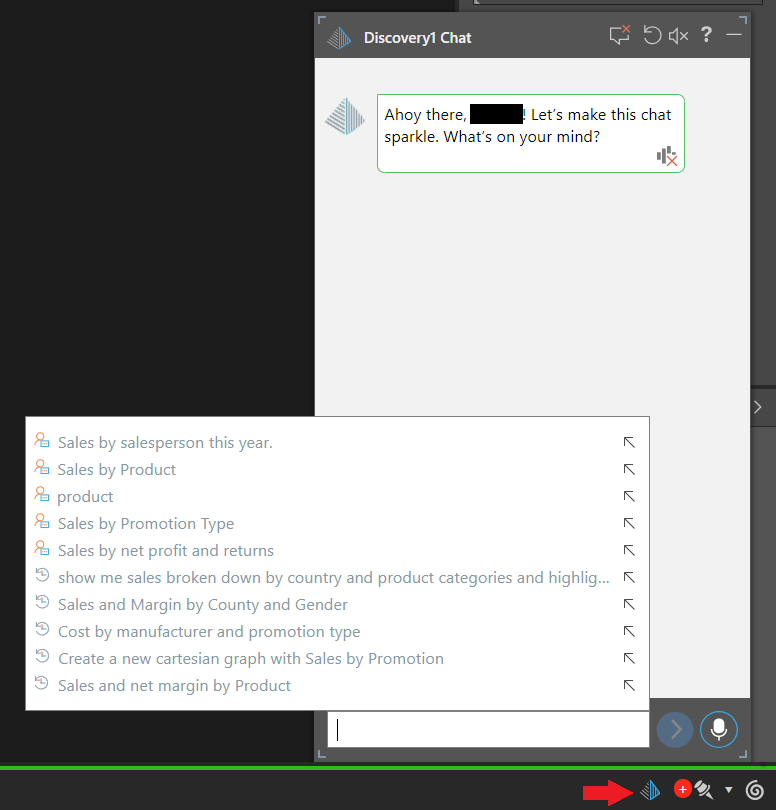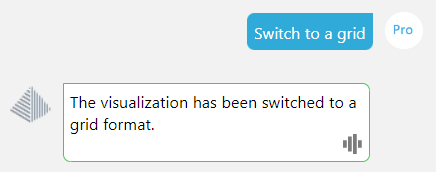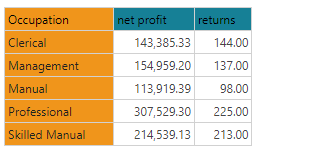In this exercise we'll build a new visual from scratch, using the Chatbot in Discover. We will explore the cumulative nature of commands used in the Chatbot and the different types of commands that we are able to use to add detail to the report.
Note: This topic will provide examples using Sales data. You should consider what data you want to use to follow the instructions.
Before you get started, you should launch Discover and create a new Discovery from an example Data Model. For more information, see Access Discover Pro.
STEP 1
Open the Chatbot from the bottom-right of the Discover window (red arrow).

Tip: You can move or resize the Chatbot at any time. Just drag it using its title bar or by pull the handle on the bottom-right of the pop-up. This may be useful if you are incrementally changing the report to help you to understand your changes.
STEP 2
Create a new, simple, report by telling the Chatbot what to draw. In this case, we want to create a Sales report that allows us to see the net profits and returns for customers with a particular profile.
- Type "Occupation by net profit and returns" into the Chatbot's text field.
- Click Run.
- If Pyramid chooses a visual that you do not think best illustrates your data, you can return to the Chatbot to ask it to change the selection. For example, if your data is shown as a Scatter Chart, you could change it to a grid by typing "Switch to a grid":
You might want to select the hierarchy Occupation and measures net profit and returns as they are offered by the "type-ahead" facility.

Pyramid processes your query using your configured LLM engine. Once it has understood what it needs to visualize, and worked out how to best present it, it builds your visual and announces that the action is complete.

The result of this step is that your selected data is shown as a grid visual. Note: If you had to change your visualization type in the last sub-step, Discover will work out everything it needs to do to affect this change and do it automatically. This means that your chips will be automatically redistributed into the correct drop zones.
STEP 3
Now we want to request some changes to this visual and return an additive result; effectively blending the two results from the two steps together:
- Without resetting the Chatbot, type a question that indicates that you want to incorporate some more information (the top 10 promotions by sales, in our example) into your visual. What you need to enter as your NLQ depends on the underlying LLM engine that you are using:
- If you are using the Pyramid Internal engine, you can assume that the engine understands that it must act cumulatively and so adding a query such as "Show top 10 promotions by sales" should work.
- If you are using one of the third-party LLM engines, you may need to be explicit that you want the additional information to be incorporated additively. For example, you may try "Show top 10 promotions for this data."
- Once your query is correct, click Run.
The result of this step is to incorporate the additive information into your visual.
If you reset your visual and ask "Show top 10 promotions by sales" as the first NLQ question, Pyramid will show something like this:

Note: Revenue is a synonym for Sales.
However, if there was an existing query ("Occupation by net profit and returns"):

And then you asked "Show top 10 promotions by sales" or "Show top 10 promotions for this data" in the Chatbot, Pyramid returns the additive result - effectively blending the two results together:

STEP 4
Save your Discovery report in "My Content" with an appropriate name.

Note: You can continue to type or say questions, elaborating on your visuals as required. For more information about the options that are available to you, see Discover Pro or Discover Lite.